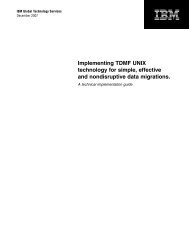Making Connections: Using SOA to enable collaboration in travel - IBM
Making Connections: Using SOA to enable collaboration in travel - IBM
Making Connections: Using SOA to enable collaboration in travel - IBM
You also want an ePaper? Increase the reach of your titles
YUMPU automatically turns print PDFs into web optimized ePapers that Google loves.
To build this solution, cus<strong>to</strong>ms would build a<br />
set of services provid<strong>in</strong>g systematic access<br />
<strong>to</strong> the regulations, duties and tariffs, and trade<br />
management systems. While <strong>SOA</strong> provides<br />
the technology standards for such a solution,<br />
the content standards are still under development.<br />
Projects such as eDocs and CBRDM<br />
are attempt<strong>in</strong>g <strong>to</strong> def<strong>in</strong>e the standards needed<br />
at a transaction level. However, solutions such<br />
as described <strong>in</strong> our example are still possible<br />
<strong>to</strong>day, and an <strong>SOA</strong> approach will position early<br />
movers for easier standard adoption <strong>in</strong> the<br />
future. For example, the EU eCus<strong>to</strong>ms <strong>in</strong>itiative<br />
provides a fertile ground for stag<strong>in</strong>g the<br />
development of these solutions. With such a<br />
conta<strong>in</strong>ed scope, <strong>in</strong>itial implementations could<br />
form the basis of future global <strong>in</strong>dustry standards.<br />
Benefits of <strong>SOA</strong><br />
Figure 5 (see page 11) shows what we believe<br />
<strong>to</strong> be a more effective and efficient means<br />
of communications between cus<strong>to</strong>ms agencies<br />
and all other trade participants. But it is<br />
important <strong>to</strong> note that the solution described<br />
<strong>in</strong> the last section would not be a practical and<br />
general solution for all. It will be most attractive<br />
<strong>to</strong> the largest and most significant traders,<br />
which represent a critical market segment with<br />
high value <strong>to</strong> their national economies. For this<br />
market segment, there are benefits <strong>to</strong> both the<br />
trade participants and the cus<strong>to</strong>ms organizations.<br />
Second, there are two areas of bus<strong>in</strong>ess<br />
processes <strong>to</strong>uched <strong>in</strong> our scenario: supply<br />
cha<strong>in</strong> <strong>in</strong>formation availability and <strong>in</strong>tegra-<br />
13 <strong>Mak<strong>in</strong>g</strong> connections<br />
tion, and the more visionary, future option of<br />
clearance data submission direct <strong>to</strong> cus<strong>to</strong>ms<br />
organizations. For a more practical view, let’s<br />
exam<strong>in</strong>e the benefits that surface strictly from<br />
the former, the ability for cus<strong>to</strong>ms <strong>to</strong> openly<br />
share <strong>in</strong>formation needed <strong>to</strong> support the<br />
supply cha<strong>in</strong> and all trade participants.<br />
For cus<strong>to</strong>ms organizations, an <strong>SOA</strong> approach<br />
can provide a s<strong>in</strong>gle connection po<strong>in</strong>t for<br />
both external and <strong>in</strong>ternal access <strong>to</strong> cus<strong>to</strong>ms<br />
systems. This technical strategy supports<br />
the “s<strong>in</strong>gle w<strong>in</strong>dow” <strong>in</strong>itiatives recommended<br />
by the WCO SAFE Framework of Standards,<br />
provid<strong>in</strong>g an ideal technology platform for<br />
cus<strong>to</strong>ms <strong>to</strong> <strong>in</strong>tegrate with other government<br />
agencies <strong>in</strong>volved <strong>in</strong> <strong>in</strong>ternational trade. Given<br />
that is impossible for cus<strong>to</strong>ms <strong>to</strong> predict who<br />
will need <strong>to</strong> connect for <strong>in</strong>formation, the <strong>SOA</strong><br />
approach allows a cus<strong>to</strong>ms organization <strong>to</strong><br />
build a s<strong>in</strong>gle set of services for all participants.<br />
These services are “exposed” or made<br />
available on the Internet. Trade participants<br />
then can decide, based on a bus<strong>in</strong>ess case,<br />
whether it is of value for them <strong>to</strong> use these<br />
services.<br />
In the example of Figure 5, cus<strong>to</strong>ms has<br />
provided services <strong>to</strong> obta<strong>in</strong> regulation <strong>in</strong>formation,<br />
obta<strong>in</strong> duties and tariffs, and <strong>to</strong> validate<br />
and submit trade details for approval. With<br />
<strong>SOA</strong>-<strong>enable</strong>d systems, buyers, sellers and<br />
support<strong>in</strong>g players can access exposed<br />
services <strong>in</strong> a controlled manner. Cus<strong>to</strong>ms<br />
has the ability <strong>to</strong> change or revise its systems<br />
without disruption <strong>to</strong> other players.

















